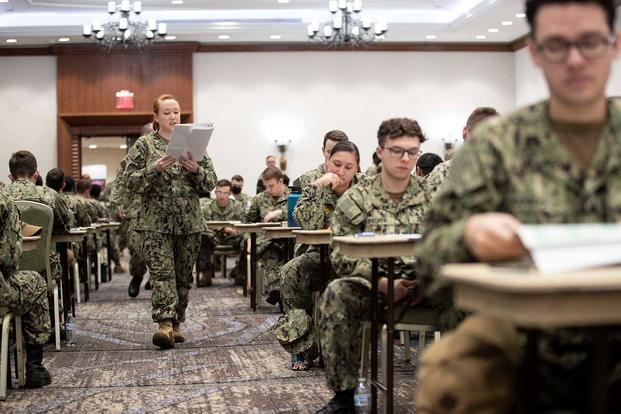Before beginning to study for the Navy-Wide Advancement Exam, it's a good idea to figure out your learning style. There are five broad categories of learning styles: visual learners, auditory learners, reading and writing learners, tactile (touch) learners and mathematical or logical learners. Additionally, all learners can be classified as either solitary or social learners.
Here's a rundown of each type of learning and how you can cater to what works best for you.
Visual Learners
Visual learners benefit from colorful details, visual presentations, pictures, charts, graphics and even using highlighters or colored pens to draw attention to their learning materials. When selecting study materials, visual learners should look for materials that have a lot of visual information and appeal.
If this is you, you'll find it helpful to study in an area free from visual distractions, such as not having the television on in the background, so that your focus is on the material and not the environment. If you are having trouble with learning any content or a certain concept, try drawing or doodling the abstract idea in action, such as by illustrating a circuit diagram or sketching out the mechanical piece in question.
Auditory Learners
Auditory learners can pick up information and its meaning just by hearing it read aloud or by taking it in through any other auditory study methods. Even if reading is not how you typically retain information, reading the material out loud may help you focus on it in a way that improves your recall and comprehension skills.
Listening to podcasts of the material can also help you dramatically, as can study groups where each person takes time to read or ask questions aloud.
Reading and Writing Learners
Reading and writing learners get the most information out of reading the material directly, taking written notes or a combination of both. Reading a PDF version of the material is useful, for example, as it allows you to see all of the information available, and it also allows for either just the skimming of the material or indulging in more in-depth readings. Taking written notes or writing your own questions on flashcards can also greatly assist you in retaining and understanding the material.
Tactile (Touch) Learners
Tactile learners understand information most efficiently by "doing" and moving. Hands-on events, such as working with systems, machinery or other physical aspects of a job can help them to better understand or retain information. Other tactile or kinesthetic learning methods include taking short and frequent breaks after having "hands-on" learning sessions or doing physical movements throughout your study routine, whether that be walking, tapping your fingers, clicking a pen or playing with a fidget toy.
Mathematical or Logical Learners
Mathematical or logical learners are able to understand best from reading written material that contains abstract concepts or presents a problem-solving process. Mathematical or logical learners can get the most from their studies by asking questions of themselves as they read, such as:
- "How does that piece interact with the system?"
- "What systems impact this knowledge, and what systems does this knowledge impact?"
- "What would happen if I changed variable 'X' with this system?"
Ultimately, this kind of learner gleans information from consistent study efforts in a familiar environment so that they are not unintentionally analyzing the things around them. Trivia and contest-styled group learning efforts also greatly impact their way of learning, because they challenge these learners to provide information quickly and in a competitive setting.
Your Learning Environment: Solo or Team-Based?
Your learning style can also be defined by the environment you study in, specifically whether you study better alone or in a group.
Social Learners
Social learners learn well in group environments. Their social skills and communication expertise can assist them in converting the learning material into an easier-to-understand format for themselves and others. When each person in a study group has a different learning style, the entire group benefits.
For example, if you have trouble understanding a concept of the material, someone else in the group can explain it via their specific learning style, which could help you or anyone else in the group also better understand and retain the concept at hand. Social learners believe there is strength in numbers, and they build off of one another and their various learning styles to accomplish a collective educational goal.
Solitary Learners
Some learners are better able to understand the material when they are in their own, private environments without other people around them to serve as distractions. These learners benefit from quiet, controlled and familiar spaces where they can study free from the distractions of other voices, thoughts and other forms of intrusion. Solitary learners benefit greatly by relying on their ability to control what, when and how they study without having to spend any of their energy focusing on the wants and needs of various others in a study group.
Managing Your Learning Style
Spend some time evaluating your own learning styles and preferred learning environments to help you prepare for the Navy-Wide Advancement Exam. You can find online questionnaires that will help you to discover your optimal learning style and also give you some additional tips that will help you maximize what type of learning works best for you.
Learn More About the Navy-Wide Advancement Exam
Need more help with the Navy-Wide Advancement Exam? Check out Bluejacketeer, which gathers and prepares material for your rating with a convenient mobile app and offline study mode so you can learn anywhere.















